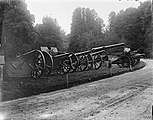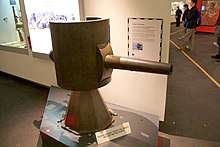5.7 cm Maxim-Nordenfelt
The 5.7 cm Maxim-Nordenfelt "Canon de caponnière" was a fortress gun and infantry gun developed during the 1880s in Britain which was sold to Belgium and later produced under license by the Cockerill company. It saw action during World War I in both Belgian and German hands.
| 5.7 cm Maxim-Nordenfelt | |
|---|---|
 A captured German 5.7 cm Maxim-Nordenfelt gun. Meaulte-Albert Road after the Battle of the Somme. | |
| Type | Fortress gun Infantry gun |
| Place of origin | |
| Service history | |
| In service | 1887-1918 |
| Used by | |
| Wars | World War I |
| Production history | |
| Designer | Maxim-Nordenfelt |
| Designed | 1887 |
| Manufacturer | Maxim-Nordenfelt |
| No. built | 185 fortress guns 450 infantry guns |
| Variants | Tank gun Anti-tank gun |
| Specifications | |
| Mass | Travel: 1,467 kg (3,234 lb) Combat: 860 kg (1,900 lb) |
| Barrel length | 1.5 m (4 ft 11 in) L/26.3[1] |
| Shell | 57 x 224R Fixed QF ammunition[2] |
| Shell weight | 2.7 kg (5 lb 15 oz) |
| Caliber | 57 mm (2.2 in) |
| Breech | Vertical sliding-block |
| Carriage | Box trail |
| Elevation | -10° to +15°[1] |
| Rate of fire | 36 rpm |
| Muzzle velocity | 401 m/s (1,320 ft/s) |
| Effective firing range | 2.7 km (1.7 mi) |
| Maximum firing range | 6.4 km (4 mi)[1] |
Design
Fortress Gun
In 1887 the Belgian War Ministry ordered 185 5.7 cm fortress guns to arm their fortresses including Namur and Liege. The 5.7 cm Maxim-Nordenfelt was a short 26 caliber gun and not the longer 42-50 caliber QF 6-pounder Nordenfelt naval gun. It was a typical built-up gun of the period made of steel with a vertical sliding-block breech and it fired fixed QF ammunition of a number of different styles. The guns were mounted in Grusonwerke gun turrets or in armored casemates on central pivot mounts and used in an anti-personnel role.[1]
Infantry Gun
In addition to its fortress gun role, it was deployed in an infantry gun role. The guns were mounted on light two-wheeled box trail carriages without a recoil mechanism and protected by a three-sided gun shield. During 1914 the Germans captured large numbers of these guns and used them in the infantry gun role mainly to engage enemy machine gun nests in support of infantry assaults. In 1916 the Germans had 450 of these infantry guns in service.[1]
Tank Gun & Anti-tank Gun
In addition to the infantry gun role, the Germans used a number of guns to arm their A7V tanks and the guns were mounted in an armored casemate at the front of the vehicle with limited traverse. The Germans also mounted a number guns on central-pivot mounts on flatbed truck chassis to act as mobile anti-tank guns.[1]
Belgian Forts
Photo Gallery
.jpg) A Belgian casemate gun recaptured by American troops.
A Belgian casemate gun recaptured by American troops. A collection of German artillery captured at The Battle of the Somme.
A collection of German artillery captured at The Battle of the Somme. The 5.7 cm Maxim-Nordenfelt is the tall shielded gun in the center.
The 5.7 cm Maxim-Nordenfelt is the tall shielded gun in the center. A7V tank gun at the Imperial War Museum.
A7V tank gun at the Imperial War Museum.
References
| Wikimedia Commons has media related to 5.7 cm Maxim-Nordenfelt. |
- Fleisher, Wolfgang (February 2015). German artillery : 1914-1918. Barnsley. p. 99. ISBN 9781473823983. OCLC 893163385.
- "48-57 MM CALIBRE CARTRIDGES". www.quarryhs.co.uk. Retrieved 2018-09-23.